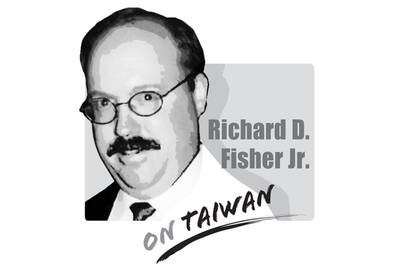Amid an emergence of "China fever" sparked by the visits to China by Chinese Nationalist Party (KMT) Chairman Lien Chan (
While reiterating that "everything is under the government's control," Chen lashed out at former president Lee Teng-hui (
It is understandable that Chen wants to establish his legacy in the reminder of his second term. But that aside, what is more valuable is the style of leadership that he might leave for the country.
The art of leadership is to maintain sufficient forward momentum to control events and steer public policy without losing public support. An idealistic leader will not hesitate to do something that is unpopular. But a smart idealist will carefully measure pubic opinion before he does so and will develop a strategy to persuade the electorate.
Since Beijing has been taking advantage of pan-blue leaders' visits to promote its "one China" principle and the so-called "1992 consensus," Chen has introduced several strategies to set the limits for Lien and Soong.
The public response so far has been the result of a lack of effective and systemic handling of cross-strait interaction. It has not only generated growing pressures for the Chen administration, but has created uncertainty about the DPP's campaign for tomorrow's National Assembly election. Chen's leadership will be severely jeopardized if more prudence and patience are not incorporated. Chen stands at a critical historical juncture in terms of leading the country to bridge domestic divisions and the cross-strait divide, while at the same time safeguarding the nation's sovereignty, dignity and democratic achievements.
Defining Lien's and Soong's "journeys" as just a "prelude" to the eventual and necessary "government-to-government negotiations" between him and Chinese President Hu Jintao (
Confidence-building and domestic unity are key, given that the country is split by "China fever" versus "Taiwan first." But Chen must try to control the tempo of cross-strait dynamics.
What Chen needs right now is spin control and the ability to manipulate key issues. Persuasion and candid communication are two necessary mechanisms to educate the public on the seriousness of the situation and to eliminate confusion.
As a national leader, Chen should also understand there is a vital synergy between issues and image. Rather than a presidential stand on the issues creating a desired image, the desired image was first identified, then issues were selected based on how best to promote that new image. By throwing out key issues and creating a public arena for discussion, the president can control the pace and the extent of policy making based on the majority's opinions. Image has molded and directed the political agenda, not the other way around.
Chen must foresee the changes in Taiwanese society. As he lowered his voice, he raised his ratings. When he attempted to cross party lines to advocate a balanced resolution on essential social and economic legislation, he moved into the ascendancy. The pan-blue camp could not find any excuses to politicize such a moderate move. However, he must be seen to be consistent, not flip-flopping on issues.
Liu Kuan-teh is a Taipei-based political commentator.

On Sept. 3 in Tiananmen Square, the Chinese Communist Party (CCP) and the People’s Liberation Army (PLA) rolled out a parade of new weapons in PLA service that threaten Taiwan — some of that Taiwan is addressing with added and new military investments and some of which it cannot, having to rely on the initiative of allies like the United States. The CCP’s goal of replacing US leadership on the global stage was advanced by the military parade, but also by China hosting in Tianjin an August 31-Sept. 1 summit of the Shanghai Cooperation Organization (SCO), which since 2001 has specialized
In an article published by the Harvard Kennedy School, renowned historian of modern China Rana Mitter used a structured question-and-answer format to deepen the understanding of the relationship between Taiwan and China. Mitter highlights the differences between the repressive and authoritarian People’s Republic of China and the vibrant democracy that exists in Taiwan, saying that Taiwan and China “have had an interconnected relationship that has been both close and contentious at times.” However, his description of the history — before and after 1945 — contains significant flaws. First, he writes that “Taiwan was always broadly regarded by the imperial dynasties of
The Chinese Communist Party (CCP) will stop at nothing to weaken Taiwan’s sovereignty, going as far as to create complete falsehoods. That the People’s Republic of China (PRC) has never ruled Taiwan is an objective fact. To refute this, Beijing has tried to assert “jurisdiction” over Taiwan, pointing to its military exercises around the nation as “proof.” That is an outright lie: If the PRC had jurisdiction over Taiwan, it could simply have issued decrees. Instead, it needs to perform a show of force around the nation to demonstrate its fantasy. Its actions prove the exact opposite of its assertions. A
A large part of the discourse about Taiwan as a sovereign, independent nation has centered on conventions of international law and international agreements between outside powers — such as between the US, UK, Russia, the Republic of China (ROC) and Japan at the end of World War II, and between the US and the People’s Republic of China (PRC) since recognition of the PRC as the sole representative of China at the UN. Internationally, the narrative on the PRC and Taiwan has changed considerably since the days of the first term of former president Chen Shui-bian (陳水扁) of the Democratic